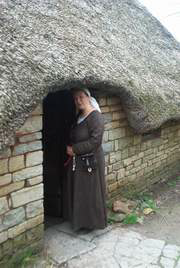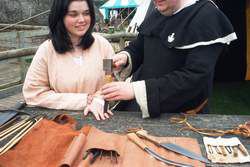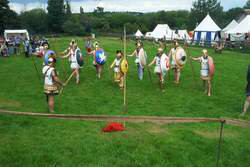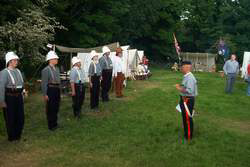Abandoned Communities ..... Cosmeston
On my last visit I had the pleasure of spending an hour in the company of Mistress Angharad. Mistress Angharad was once a nun but is now married to Lowell Longshank, butler to the lord of the manor, Sir William de Caversham. At the age of 14 she was sent by her father to the convent at Ewenny, but about four years later Lowell Longshank was visiting the convent to make a tithe delivery when Angharad did espy him. She persuaded her father to make a donation to the convent of a dozen barrels full of the sweetest apples, and she was then allowed to leave. Soon afterwards Angharad and Lowell were wed. They now have three children, including Rhys, aged 11, who is an apprentice cooper in Cardiff. Even now Angharad feels obliged to atone for leaving the convent by working hard in the garden behind the Tithe Barn.
At 12 o’clock Mistress Angharad received a call on her mobile phone to tell her that a group of visitors were waiting for her guided tour. I left her and walked back to the Tithe Barn, just in time to join a party of ten year olds settling down for a presentation on medieval weapons and armour. We learnt about the type of chain mail and helmet worn by knights. Crude methods of manufacture meant that their combined weight was considerable, but there is no truth in the rumour that knights were winched onto their horses. They had to be fit enough to vault on.
Options for an attacker armed with a short sword were described in vivid detail. They included (a) thrust your sword upwards through the knight’s chin, through the face and up into the brain, (b) stab the knight through the armpit and run your sword into his heart, (c) force your sword through the knight’s backside, and if you were lucky enough to pierce a main artery the jet of blood would cover an area 12 feet in diameter, and (d) thrust the sword through an eye, twist the sword, smash open the nose, force the cheek open, and keep on pushing until your sword enters the brain, which would then be seen dripping out of the front of the helmet.
Reactions to this part of the presentation included gasps of horror and laughter. One or two people I have spoken to about it have raised questions about the attitude to violence it may tend to convey.
On bank holiday weekends special events will be laid on, and members of various re-enactment societies will demonstrate their skills. Visitors may have an opportunity to take an archery lesson, place a younger family member in the stocks, or meet the surgeon. Conversations with the surgeon are again likely to turn to the topic of injury and physical pain. The surgeon, Simeon the Sais, otherwise known as Richard, who comes all the way from England, believes that pain is good for the soul. His methods of surgery include sawing and chopping, and then sewing up. Some patients have to be held down, but he is willing to allow the use of alcohol in advance and to give patients something to bite on.
Some of the re-enactment societies, such as the Companions of the Crow and one called Knights et Armis, fit well into the re-creation of fourteenth century life in South Wales. You are, however, likely to meet groups intent on reproducing military activities from many other periods of history and parts of the world. You may come across Greek hoplites from the fifth century BC, infantry from the time of the English Civil War, soldiers from the Napoleonic Wars Group, and members of the 1879 Society engaged in wars with the Zulu people of South Africa.
To read an account in the Penarth Times of a typical day’s entertainment at Cosmeston click here.
At 12 o’clock Mistress Angharad received a call on her mobile phone to tell her that a group of visitors were waiting for her guided tour. I left her and walked back to the Tithe Barn, just in time to join a party of ten year olds settling down for a presentation on medieval weapons and armour. We learnt about the type of chain mail and helmet worn by knights. Crude methods of manufacture meant that their combined weight was considerable, but there is no truth in the rumour that knights were winched onto their horses. They had to be fit enough to vault on.
Options for an attacker armed with a short sword were described in vivid detail. They included (a) thrust your sword upwards through the knight’s chin, through the face and up into the brain, (b) stab the knight through the armpit and run your sword into his heart, (c) force your sword through the knight’s backside, and if you were lucky enough to pierce a main artery the jet of blood would cover an area 12 feet in diameter, and (d) thrust the sword through an eye, twist the sword, smash open the nose, force the cheek open, and keep on pushing until your sword enters the brain, which would then be seen dripping out of the front of the helmet.
Reactions to this part of the presentation included gasps of horror and laughter. One or two people I have spoken to about it have raised questions about the attitude to violence it may tend to convey.
On bank holiday weekends special events will be laid on, and members of various re-
Some of the re-
To read an account in the Penarth Times of a typical day’s entertainment at Cosmeston click here.
Four
Mistress Angharad
Richard the surgeon about to perform an amputation
A squad of Greek hoplites
Members of the 1879 Society preparing for battle with the Zulus



